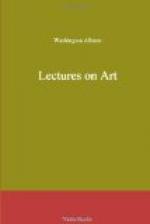When, in respect to certain objects, the effects are found to be uniformly of the same kind, not only upon ourselves, but also upon others, we may reasonably infer that the efficient cause is of one nature, and that its uniformity is a necessary result. And, when we also find that these effects, though differing in degree, are yet uniform in their character, while they seem to proceed from objects which in themselves are indefinitely variant, both in kind and degree, we are still more forcibly drawn to the conclusion, that the cause is not only one, but not inherent in the object.[2] The question now arises, What, then, is that which seems to us so like an alter et idem,—which appears to act upon, and is recognized by us, through an animal, a bird, a tree, and a thousand different, nay, opposing objects, in the same way, and to the same end? The inference follows of necessity, that the mysterious cause must be in some general law, which is absolute and imperative in relation to every such object under certain conditions. And we receive the solution as true,—because we cannot help it. The reality, then, of such a law becomes a fixture in the mind.
But we do not stop here: we would know something concerning the conditions supposed. And in order to this, we go back to the effect. And the answer is returned in the form of a question,—May it not be something from ourselves, which is reflected back by the object,—something with which, as it were, we imbue the object, making it correspond to a reality within us? Now we recognize the reality within; we recognize it also in the object,—and the affirming light flashes upon us, not in the form of deduction, but of inherent Truth, which we cannot get rid of; and we call it Truth,—for it will take no other name.
It now remains to discover, so to speak, its location. In what part, then, of man may this self-evidenced, yet elusive, Truth or power be said to reside? It cannot be in the senses; for the senses can impart no more than they receive. Is it, then, in the mind? Here we are compelled to ask, What is understood by the mind? Do we mean the understanding? We can trace no relation between the Truth we would class and the reflective faculties. Or in the moral principle? Surely not; for we can predicate neither good nor evil by the Truth in question. Finally, do we find it identified with the truth of the Spirit? But what is the truth of the Spirit but the Spirit itself,—the conscious I? which is never even thought of in connection with it. In what form, then, shall we recognize it? In its own,—the form of Life,—the life of the Human Being; that self-projecting, realizing power, which is ever present, ever acting and giving judgment on the instant on all things corresponding with its inscrutable self. We now assign it a distinctive epithet, and call it Human.




